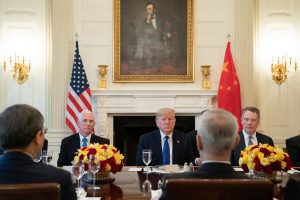To what extent can the United States control the global spread of technology, and under what circumstances should it do so? A recently established project at the Center for New American Security (CNAS) has begun to examine the theory and practice of U.S. export control policy. Although export controls have been around for a long time, this is an overdue and promising avenue of analysis into one of the most important tools of U.S. economic and defense statecraft.
Broadly speaking, the ability of the executive branch to control the export of technology stems from the Curtiss-Wright vs. United States case of 1936, which ruled that the Roosevelt administration could, with broad authorization from Congress, regulate the international export of technology with military application. A raft of legislation before and after World War II clarified the legal authority behind export controls, targeting the Axis first and then the Soviet Union. During the Cold War, export controls were critical to maintaining and extending the West’s technological edge over the Soviet Union. More recently, in 2018 the Export Control Reform Act gave the executive branch the broad authority to impose export controls directed at China’s military and dual-use technology industries.
The CNAS project has thus far produced some interesting insights. Just as in the Cold War, export controls depend utterly on the ability of the U.S. to produce a coalition. Controls imposed by Washington are of little help if allies are uninterested in observing them, or if allies prefer a system in which China is a full player. Export controls can be a double-edged sword, because if they are too onerous they can cut off U.S. industry from global developments by scaring off potential partners. Even American firms may offshore certain modes of production if they fear that the export control hammer will fall on their products. Finally, export controls may serve to convince targets and prospective targets simply to indigenize production, thus reducing their dependence on the U.S.
Notably, the Trump administration has been ambiguous as to whether the purpose of the high tech export controls it has imposed are intended to punish China for technology theft, to undercut the Chinese defense industrial base or to hurt the Chinese economy over the long-term.
To borrow terminology from Thomas Schelling, export controls tend to differ from sanctions in that they represent “brute force” rather than a “coercive” effort. The intention behind export controls is generally not to change a target’s behavior, although the State Department may pay lip service to the notion that China or Russia could get themselves out of trouble by changing their policies. Rather, the point is to inflict damage upon the defense industrial base and civilian technology base of the opponent by denying them access to certain technologies that are available to other advanced economies. In the long run, this gives the governments imposing the export controls a technological and economic advantage. The use of export controls to inflict harm on the broader civilian economy is more controversial than their use as tools of defense statecraft. However, the explosion in dual-use technologies necessarily means a) that civilian technologies must be subject to control, and b) that export controls will inflict damage on the civilian economy of the target as well as its defense industrial base.
For its part, China has accused the U.S. of creating market distortions and disregarding the rules of international trade. China has also begun to restructure its technological industrial base in order to indigenously produce the chips and other equipment that it can no longer acquire from the U.S. Intellectual property rights have complicated this effort, as American firms hold key patents in some areas that make it difficult for Chinese companies to compete on international markets.
In any case, the CNAS project (which will hopefully in the future examine the extent to which export controls and intellectual property protection interact and coincide) is a valuable contribution on one of the most important tools of U.S. policy toward China. Hopefully, it will help to develop a more nuanced conversation on how to manage technological competition while also protecting U.S. industry.

































